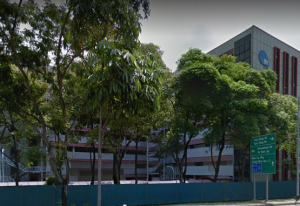Two-storey industrial building near Tuas Second Link up for sale for S$8 million
A two-storey JTC factory at 33 Tuas Basin Link Road has been put up for sale by Expression of Interest (EOI), at a guide price of S$8 million.

Located near the Second Link at Tuas and the upcoming Tuas Mega Port, the two-storey industrial building is well-positioned to meet the operational and logistical needs of firms that deal with international trade.
Connectivity to the two-storey industrial building is further enhanced by its proximity to both Gul Circle and Tuas Crescent MRT stations, offering convenience and ease of access to employees commuting from neighbouring Malaysia.
Table of Contents
The facility is ideal for general industry use, such as manufacturing, precision engineering, bio-medical, electronics and logistics or distribution industries. Under the Master Plan 2019, the two-storey industrial building is zoned B2 with maximum allowable plot ratio of 1.4. It has a land area of 4,633.40 sqm (approx. 49,873.45 sq ft) and gross floor area of 3,927.79 sqm (approx. 42,278.33 sq ft).
The two-storey industrial building enjoys excellent main road frontage along Pioneer Road and has long balance land tenure of 33 years.
Knight Frank Singapore has been exclusively appointed to market the two-storey industrial building.
Daniel Ding, Head of Capital Markets for Land & Building, International Real Estate & Industrial, Knight Frank Singapore, says, “The proximity of the property to the Tuas Amenity Centre, Tuas Megaport and two MRT stations certainly renders this an attractive opportunity for business owners. In addition, the balance land tenure of 33 years is a premium over most land tenures from industrial government land sales plots that are in the vicinity.”
The EOI for 33 Tuas Basin Link Road will close on 13 October 2020, at 3pm.
Industrial property market emerged one of the most resilient across the property sectors says a recent analysis of JTC Q2 2020 Industrial property statistics.
Ms Tricia Song, Colliers International’s Head of Research for Singapore, commenting analysing that industrial property market emerged among most resilient sectors from the JTC Q2 2020 Industrial property statistics said:
“The Singapore industrial property market emerged one of the most resilient across the property sectors (retail, office, hotel, residential), amid the global coronavirus (COVID-19) pandemic, as seen by continued warehouse demand supported by the accelerated adoption of e-commerce and government’s stockpiling of essential goods.
“That said, overall industrial rental and price declines were more pronounced in Q2 2020 than in Q1 2020, capturing the ground sentiments and impact of COVID-19 Circuit Breaker measures which started on 7 April 2020. With the rapidly evolving COVID-19 situation, the industrial sector is likely to experience continued pressures on rents and prices, as with other sectors.
“Singapore all-Industrial property market rents declined 0.7% quarter-on-quarter (QOQ) in Q2, dragged by single-user factory. Business parks held up best but still declined 0.2% QOQ. Despite the weakness in rents, overall occupancy rate, however, rose marginally to 89.4% from 89.2%. Meanwhile, prices of industrial properties saw a decline of 1.1% QOQ, attributing largely to the 1.5% QOQ decline seen in multi-user factories.
“Overall, we are cautious about Singapore industrial market’s outlook for this year, and forecast the general industrial market to remain weak in 2020.
“The business park and high-specs segments could be more resilient, benefiting from Technology sector. Warehouses could see support from the rise in e-commerce driving demand for logistics services, and are also well-positioned for any economic rebound.”
Rents and Occupancy Rate
The All-Industrial rental index declined at an increasing rate, registering a -0.7% QOQ growth, dragged largely by single-user factory (-1.0%) and warehouse (-0.7%). This came after a 0.1% decline in Q1 2020. This also marks the highest quarterly decline since Q3 2017, and brings the All-Industrial rental index to a level at 14.2% below the peak in Q2 2014.
However, overall occupancy rates improved 0.2 percentage point (ppt) to 89.4% in Q2 2020 from 89.2% in Q1 2020, mainly due to an 0.8 ppt increase in warehouse space; more space was leased due to stockpiling and storage during the quarter. Other segments saw a decline in occupancy levels, with business parks falling the most.
Factory
The single-user factory segment saw rents declining 1.0% QOQ which helped pushed up occupancy by 0.4 ppt to 91.1% (+0.4 ppt). While rents of multi-user factories held up slightly better at -0.5% QOQ, occupancy declined by 0.4 ppt to 87.5%. All planning regions saw a decline in rents, with the worst decline seen in the East at -2.1% QOQ.
Business Park
Business Park rents held up best among all segments, with only a marginal decline of 0.2% QOQ in Q2 2020. That said, this is the first rental decline seen for business parks since Q4 2018, as the global COVID-19 pandemic dampened business sentiment and leasing activities in business parks and high-spec spaces. Occupancy rate also declined by 0.7 ppt QOQ to 85.2% as businesses paused expansion activities and net new demand remained negative for the second consecutive quarter.
Warehouse
Warehouses saw a surge in net new demand to 1.3 million sq ft from -125,000 sq ft in Q1 2020, as the pandemic resulted in national stockpiling of essential goods and accelerated e-commerce growth. Lower rents (-0.7% QOQ) in Q2 2020 drove occupancy up by 0.9 ppt to 88.3%.
Prices
The All-Industrial price index fell 1.1% QOQ in Q2 2020, dragged by the multi-user factory segment which saw a -1.5% QOQ decline, while single-user factory also witnessed a -0.6% QOQ decline.
Colliers notes that the price index for multiple-user factory has not seen an improvement for seven consecutive quarters. Prices in all planning regions fell in Q2 2020, with the West and North region seeing the largest drop at -4.0% QOQ and -3.5% QOQ respectively.
Future Supply in the industrial property market
Only 0.2 million sqm (approx. 2,152,782 sq ft) of new industrial space was completed in Q2 2020 due to the impact of COVID-19 Circuit Breaker measures on the construction sector. For the next two quarters, another 1.3 million sqm (approx. 13,993,083 sq ft) of industrial space are scheduled to be completed, of which: 39% is in multiple-user factory, 39% in single-user factory, 20% in warehouse and 2% in business park.
This is a sharp reduction from the previously expected 2.1 million sqm (approx. 22,604,212 sq ft) of stock to be completed in 2020 as reported in Q1 2020. Further delays are expected as project owners and contractors adjust to meet BCA’s Safe Restart requirements.
Beyond 2020, overall industrial supply that was previously expected to come through in 2021, are now pushed out to 2023. Based on JTC’s forecasts, average net industrial supply in 2021-2022 is now 13.2 million sq ft p.a. versus 2023’s 4.9 million sq ft.





